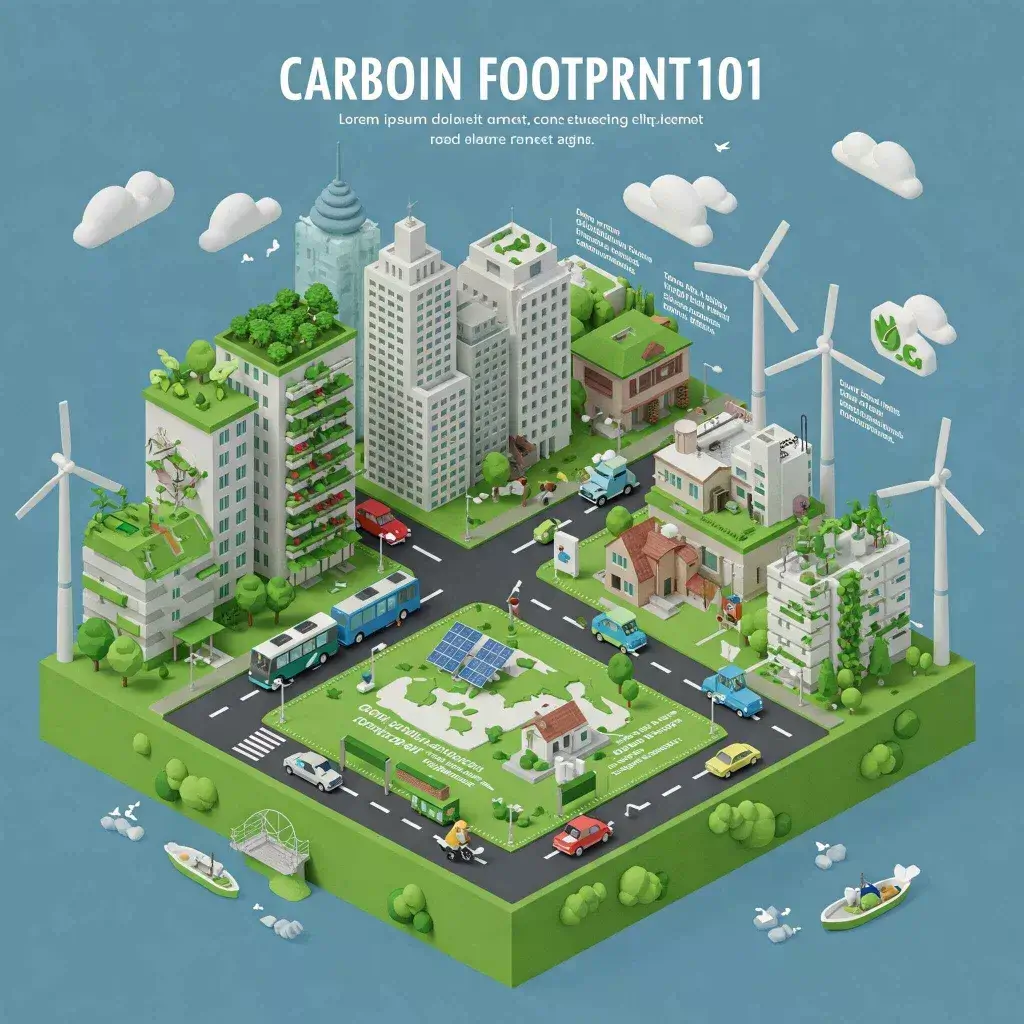1. Introduction
- Understanding your carbon footprint is the first step in reducing your environmental impact. A carbon footprint measures the total greenhouse gas emissions caused directly and indirectly by an individual, organization, or product. By making conscious choices, we can minimize our contribution to climate change.
- This article explores what a carbon footprint is, why it matters, and actionable steps you can take to lower yours.
2. What Is a Carbon Footprint?
Definition: A carbon footprint refers to the total amount of carbon dioxide (CO₂) and other greenhouse gases emitted due to human activities.
Measurement: It is typically measured in metric tons of CO₂ equivalent per year.
Direct vs. Indirect Emissions: Direct emissions come from activities like driving, while indirect emissions come from products and services we use.
Major Contributors: Fossil fuel consumption, deforestation, and industrial production.
Global Impact: Carbon footprints contribute to climate change, leading to rising temperatures and environmental degradation.
3. The Environmental Impact of High Carbon Footprints
Global Warming: Excess greenhouse gases trap heat in the atmosphere, raising temperatures.
Extreme Weather: Higher carbon emissions contribute to hurricanes, droughts, and wildfires.
Rising Sea Levels: Melting polar ice caps lead to increased coastal flooding.
Biodiversity Loss: Many species are at risk due to changing climates and habitat destruction.
Air Pollution: High carbon emissions result in poor air quality, causing health issues.
4. How to Calculate Your Carbon Footprint
| Category | Common Sources | Estimated Emissions |
| Transportation | Driving cars, air travel, public transit | High |
| Energy Use | Electricity, heating, cooling | Moderate-High |
| Food Consumption | Meat, dairy, processed foods | Moderate-High |
| Waste Generation | Landfills, plastic waste, non-recycling habits | Moderate |
| Shopping Habits | Fast fashion, electronics, non-sustainable goods | High |
5. Reducing Your Carbon Footprint: Transportation
Use Public Transit: Buses and trains reduce per-person emissions.
Carpool or Rideshare: Reduces the number of vehicles on the road.
Switch to Electric Vehicles: EVs produce lower emissions than gas-powered cars.
Walk or Bike More: Zero-emission transportation is both eco-friendly and healthy.
Limit Air Travel: Opt for video calls instead of flying for meetings.
6. Reducing Your Carbon Footprint: Energy Consumption
Switch to Renewable Energy: Solar and wind power reduce reliance on fossil fuels.
Upgrade to Energy-Efficient Appliances: Look for ENERGY STAR-rated devices.
Unplug Electronics: Reduce phantom energy waste from idle devices.
Use Smart Thermostats: Optimizes heating and cooling for energy efficiency.
Switch to LED Lighting: Uses less energy and lasts longer than incandescent bulbs.
7. Reducing Your Carbon Footprint: Food Choices
Eat Less Meat and Dairy: Livestock farming is a major contributor to emissions.
Support Local Farmers: Reduces transportation emissions from imported foods.
Choose Organic Products: Organic farming uses fewer chemicals and preserves soil health.
Reduce Food Waste: Plan meals and store food properly to avoid spoilage.
Grow Your Own Food: Home gardens provide fresh, eco-friendly produce.
8. Reducing Your Carbon Footprint: Waste Management
Recycle and Compost: Reduces landfill waste and repurposes organic materials.
Use Reusable Bags and Bottles: Limits plastic pollution.
Avoid Single-Use Plastics: Switch to glass, metal, or biodegradable alternatives.
Buy Second-Hand Products: Reduces manufacturing emissions.
Donate Unwanted Items: Prevents waste and helps those in need.
9. Reducing Your Carbon Footprint: Shopping and Lifestyle Choices
Choose Sustainable Brands: Look for companies that prioritize eco-friendly production.
Buy Fewer, Higher-Quality Items: Reduces waste and long-term expenses.
Opt for Digital Products: E-books, online billing, and streaming reduce physical waste.
Use Minimal Packaging: Buy in bulk and avoid excessive plastic wrapping.
Adopt a Minimalist Lifestyle: Less consumption equals a lower carbon footprint.
10. The Role of Technology in Reducing Carbon Footprints
Smart Home Devices: Automate energy use with smart thermostats and lighting.
Eco-Friendly Apps: Track energy consumption and find sustainable solutions.
Electric Vehicles: Reduce transportation emissions with battery-powered cars.
Remote Work Tools: Video conferencing cuts travel emissions.
Digital Payments: Online transactions save paper and fuel from bank visits.
11. Encouraging Others to Reduce Their Carbon Footprint
Educate Family and Friends: Share information on sustainability.
Participate in Green Challenges: Join community efforts to promote eco-friendly habits.
Advocate for Policy Changes: Support government initiatives for clean energy.
Support Eco-Friendly Businesses: Buy from companies committed to sustainability.
Lead by Example: Demonstrate sustainable practices in daily life.
12. The Long-Term Benefits of Lowering Your Carbon Footprint
Healthier Environment: Cleaner air, water, and food sources.
Cost Savings: Lower energy bills and reduced spending on disposable items.
Sustainable Future: Ensures resources for future generations.
Energy Independence: Less reliance on fossil fuels and imported energy.
Stronger Communities: Encourages collective action for a greener world.
13. Resources to Help You Reduce Your Carbon Footprint
| Resource Type | Example Tools & Websites | Purpose |
| Carbon Footprint Calculators | EPA Carbon Footprint Calculator, CoolClimate Network | Measure personal impact |
| Energy-Saving Apps | JouleBug, EnergyHub | Track and reduce energy use |
| Sustainable Shopping Apps | Good On You, DoneGood | Find eco-friendly brands |
| Transportation Apps | Google Maps (eco-friendly routes), Transit App | Reduce travel emissions |
| Eco-News Websites | Climate Reality, Treehugger | Stay informed on sustainability |
14. Conclusion
Reducing your carbon footprint is not just about big changes—it’s about making consistent, eco-conscious choices in daily life. From energy-efficient habits to smarter shopping and waste reduction, every effort counts. By leveraging technology, making mindful lifestyle changes, and spreading awareness, we can collectively work toward a more sustainable planet.
Disclaimers
The estimated carbon footprint values may vary based on individual usage patterns and regional factors.
The effectiveness of suggested strategies depends on implementation and personal circumstances.
Renewable energy availability may vary depending on location and infrastructure.
The listed apps and services are for informational purposes and do not constitute endorsements.
Sustainability efforts should be complemented by broader systemic changes for long-term impact.
Author: Dipika Kumari
Publication Date: 27-03-2025
Email: [email protected]
